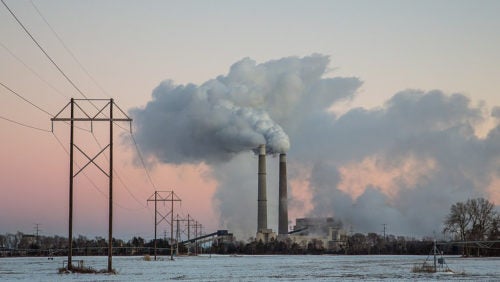Did You Get the Memo? Latest Guidance from Trump’s EPA Sparks Controversy
February 21, 2019 by Kathryn Priester

Environmental groups and the State of California are up in arms over an EPA memo scrapping a decades-old Clean Air Act policy. Will the DC Circuit weigh in on the EPA’s use of “guidance” to drastically shift US regulatory policy?
Last week, the State of California and several environmental groups filed in the DC Circuit seeking review of the Environmental Protection Agency’s decision to change its policy on “major” polluters under the Clean Air Act (CAA).[1] The new policy, outlined in a guidance memorandum known as the “Wehrum Memo,” allows plants originally classified as “major sources” to be reclassified during new source review (NSR) as “area sources” upon reaching emissions below the hazardous air pollutant (HAP) thresholds set by the Act.[2] “Major sources” are defined by the CAA as plants emitting, or with the potential to emit, 10 tons per year of any single HAP or 25 tons per year or more of any combination of HAPs.[3] In contrast, “area sources” that emit HAPs below the “major source” statutory thresholds are subject to far less stringent controls and oversight and are not required to meet “Maximum Achievable Control Technology” (MACT) emission levels required of major sources under section 112 of the CAA.[4] By allowing reclassification, the Wehrum Memo withdraws the longstanding “once in, always in” policy outlined by a 1995 memo known as the “Seitz Memo.”[5]
In the Wehrum Memo, Air and Radiation Assistant Administrator William Wehrum contends that the purpose of withdrawing the “once in, always in” policy is to better align with the plain language of section 112 of the CAA.[6] Wehrum also argued in testimony before Congress in May 2018 that this policy change will help incentivize plants to install more efficient technology[7] and simplify the program consistent with the EPA’s new “back to basics” mission statement.[8]
The EPA previously sought comment on amending the “once in, always in” policy in 2007, but it ultimately abandoned the effort after “Regional Administrators, along with a chorus of state pollution-control agencies, voiced concerns that the proposed rule would significantly increase emissions.”[9] The Wehrum Memo, California claims, changed the policy “without providing any notice or opportunity for comment.”[10] This is not an isolated event: Wehrum and the EPA have released multiple “guidance memos,” and some see the approach as a way for Wehrum to avoid seeing a repeat of his first stint at the EPA from 2005-2007, when many regulations were overturned in court.[11]
In its brief to the DC Circuit, California argues that Wehrum’s guidance memo is a reviewable final action under the Administrative Procedure Act (APA) because it has the “binding legal effects” of creating new obligations for regulators, as well as creating new rights for plants by easing permitting and compliance standards.[12] The California Brief further argues that the Wehrum Memo violates the APA—specifically, 5 U.S.C. § 553(b)-(d)—because it makes a substantive policy change outside the required rulemaking process rather than simply clarifying a regulatory term.[13] California finally contends that even if the EPA’s action is statutorily authorized and the memo is exempt from notice and comment, the Wehrum Memo’s findings are arbitrary and capricious because they “entirely ignore[]” the facts and rationale of the Seitz Memo.[14]
The Wehrum Memo is just one of many environmental policy rollbacks undertaken to further the Trump Administration’s goal of so-called “regulatory certainty.”[15] Environmental groups have also voiced concern that Mr. Wehrum’s recent EPA reforms track very closely to a “wish list” he produced in his previous job as counsel for the American Fuel and Petrochemicals Association.[16] Although Mr. Wehrum argues that the NSR process is unnecessarily confusing and simplification could spur industry to invest in efficient modifications, former EPA officials have serious concerns about the repeal of the 23 year old “once in, always in” policy.[17] Eric Schaeffer, a former head of enforcement at the EPA, told the New York Times that the decision was “reckless,” and “allows factories to switch off their pollution control systems to save a few dollars, even if that means dumping more toxic air pollution on their neighbors.”[18] It remains to be seen whether the DC Circuit will take up this challenge, but in any case, the use of guidance memos will have far reaching consequences for our nation’s environmental policy and regulatory scheme.
[1] D.C Circuit Urged to Review EPA Polluter Policy Change, Law360 (Feb. 11, 2019).
[2] Opening Proof Brief for Petitioner at 6, California Communities Against Toxics, et. al., v. EPA, No. 18-1085 (D.C. Cir February 10, 2018) [hereinafter Opening Proof Brief]. New Source Review is a permitting program which requires stationary sources of pollution to get permits before beginning construction. New Source Review, Envl. Prot. Agency ( Dec. 14, 2018), https://www.epa.gov/nsr.
[3] 42 U.S.C. § 7412(a), (2012).
[4] EPA Office of Air and Radiation, Memorandum: Reclassification of Major Sources as Area Sources Under Section 112 of the Clean Air Act (Jan. 25, 2018), at 4.
[5] Id. at 1.
[6] Id. at 3.
[7] Legislation Addressing New Source Review Permitting Program: Hearing on s. 111, 169, and 171 of the CAA Before the H. S. Comm. on Environment, 115th Cong. 3 (2018) (Opening Statement of William L. Wehrum, Assistant Administrator of the EPA).
[8] Id. at 1.
[9] Opening Proof Brief for Petitioner at 9.
[10] Id.
[11] Jennifer Lu, Smaller Bites in EPA Air Chief’s Second Pass at Permitting Update, Bloomberg Env’t (Apr. 16th, 2018), https://news.bloombergenvironment.com/environment-and-energy/smaller-bites-in-epa-air-chiefs-second-pass-at-permitting-update.
[12] Opening Proof Brief for Petitioner, supra note 2, at 11.
[13] Id.
[14] Id.
[15] Eric Lipton, As Trump Dismantles Clean Air Rules, An Industry Lawyer Delivers for Ex-Clients, N.Y. Times (Aug. 19th 2018), https://www.nytimes.com/2018/08/19/us/politics/epa-coal-emissions-standards-william-wehrum.html.
[16] Id.
[17] Id.
[18] Id.

